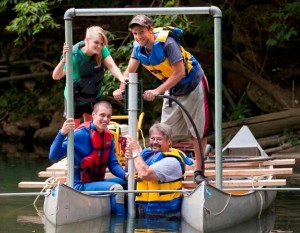
Maricate Conlon ’11 (clockwise from left), Tyler Germanoski ’12, Professor Dru Germanoski, and Michael Thompson ’12 work on the Bushkill Creek.
Just like constructing a dam on a body of water, removing one can have a major impact on the surrounding community and ecosystem. That’s why students and faculty are exploring the implications of removing the dam near Third Street on the Bushkill Creek in Easton.
Geology majors Maricate Conlon ’11 (Sandy Hook, Conn.) and Tyler Germanoski ’12 (Hellertown, Pa.), civil engineering majors Alec Bernstein ’12 (Colts Neck, N.J.) and Michael Thompson ’12 (Shokan, N.Y.), and William Barlow are working on the project, which is expected to continue through next year, with Dru Germanoski, VanArtsdalen Professor and head of geology and environmental geosciences.
Dam removal causes changes in the depth, width, and channel slope of the river, explains Conlon, who is using the research as the basis of her senior honors thesis. She is analyzing the metal concentrations of cadmium, lead, and arsenic, as well as the grain sizes of core samples, to determine if removing the dam will harm the surrounding environment. The team also is trying to predict how much sediment may be released if the dam is removed.
Collaborations like this give many Lafayette students a leg up when applying to graduate programs, according to Germanoski, who has been impressed with his students’ efforts.
“An experience like this gives the student the opportunity to do applied research,” he says. “They learn research protocol, how to adjust for unforeseen difficulties, and how to acquire, process, and interpret data. When applying to graduate school, they already have research experience and the experience of writing a thesis, which tends to provide a tremendous boost to their professional self-confidence. The quality of students that we have working for us is so high that we have complete confidence in the data they are collecting.”
Conlon has been using a mass spectrometer to determine metal concentrations and working with Steve Mylon, assistant professor of chemistry, on the chemical analysis. David Brandes, associate professor of civil and environmental engineering, is working with Conlon, Thompson, Tyler Germanoski, and Bernstein to survey the area to create a map of the channel. The students also are using a vibracorer to collect three-inch core samples of sediment under the guidance of John Wilson, lab coordinator for geology and environmental geosciences.
As a student with an eye on graduate school, Conlon recognizes that the obstacles the team faces in the field are just as valuable as the data they collect.
“[This] is different than a classroom because we are working through experiments and fieldwork that haven’t been previously done,” she says. “As we work on the Bushkill, we do encounter problems, whereas in a class most experiments are planned so that students are getting a certain lesson from a project.”
This project is part of a larger initiative looking at local flooding and water issues in partnership with the Nurture Nature Center of Easton, an organization dedicated to addressing conflicts between economic development and environmental conservation. Brandes; D.C. Jackson, professor of history; Art Kney, associate professor and head of civil engineering; Mylon; Megan Rothenberger, assistant professor of biology; and Andrew Smith, associate professor of English and chair of film and media studies, are also collaborating on the project. It is being funded by a Think Tank Grant from the Office of the Provost.

1 Comment
Comments are closed.